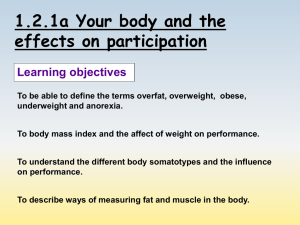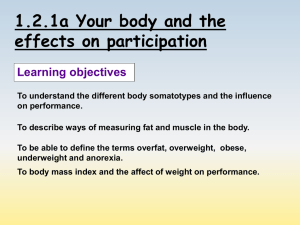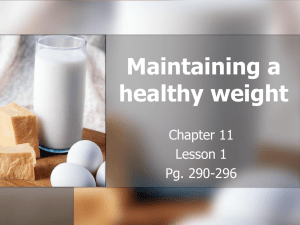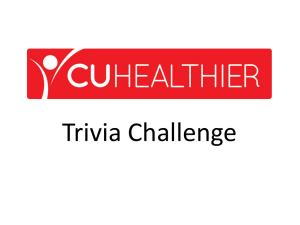LAST NIGHT CATCH UP NOTES How do Muscles Change with you
advertisement
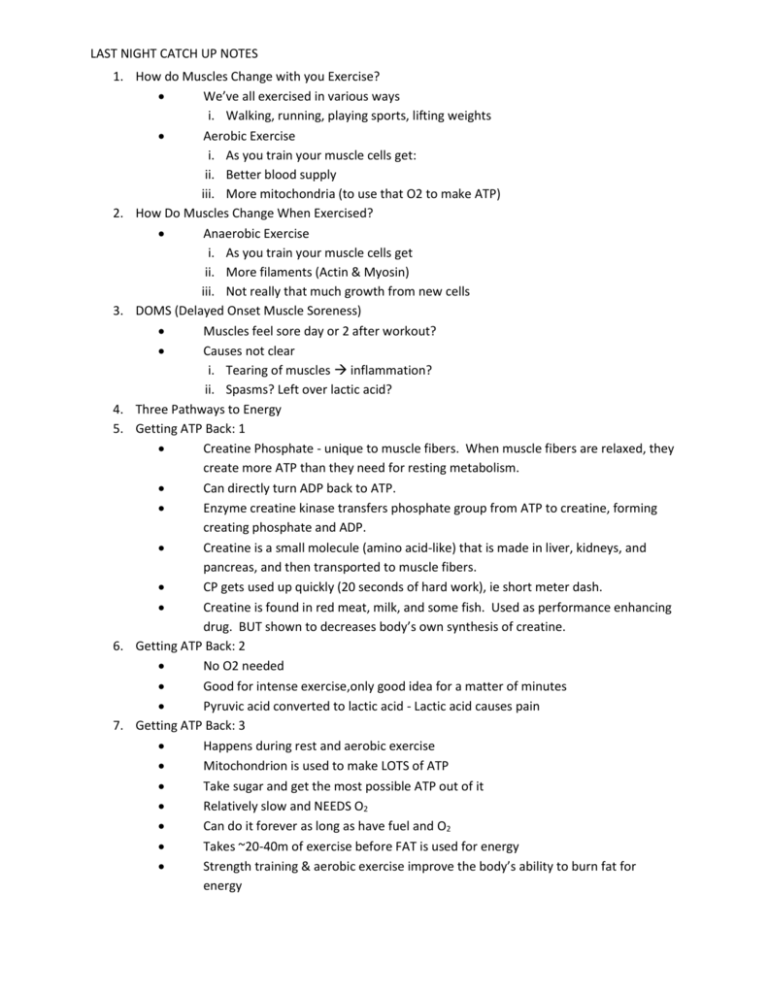
LAST NIGHT CATCH UP NOTES 1. How do Muscles Change with you Exercise? We’ve all exercised in various ways i. Walking, running, playing sports, lifting weights Aerobic Exercise i. As you train your muscle cells get: ii. Better blood supply iii. More mitochondria (to use that O2 to make ATP) 2. How Do Muscles Change When Exercised? Anaerobic Exercise i. As you train your muscle cells get ii. More filaments (Actin & Myosin) iii. Not really that much growth from new cells 3. DOMS (Delayed Onset Muscle Soreness) Muscles feel sore day or 2 after workout? Causes not clear i. Tearing of muscles inflammation? ii. Spasms? Left over lactic acid? 4. Three Pathways to Energy 5. Getting ATP Back: 1 Creatine Phosphate - unique to muscle fibers. When muscle fibers are relaxed, they create more ATP than they need for resting metabolism. Can directly turn ADP back to ATP. Enzyme creatine kinase transfers phosphate group from ATP to creatine, forming creating phosphate and ADP. Creatine is a small molecule (amino acid-like) that is made in liver, kidneys, and pancreas, and then transported to muscle fibers. CP gets used up quickly (20 seconds of hard work), ie short meter dash. Creatine is found in red meat, milk, and some fish. Used as performance enhancing drug. BUT shown to decreases body’s own synthesis of creatine. 6. Getting ATP Back: 2 No O2 needed Good for intense exercise,only good idea for a matter of minutes Pyruvic acid converted to lactic acid - Lactic acid causes pain 7. Getting ATP Back: 3 Happens during rest and aerobic exercise Mitochondrion is used to make LOTS of ATP Take sugar and get the most possible ATP out of it Relatively slow and NEEDS O2 Can do it forever as long as have fuel and O2 Takes ~20-40m of exercise before FAT is used for energy Strength training & aerobic exercise improve the body’s ability to burn fat for energy LAST NIGHT CATCH UP NOTES 8. Calories “In” – What are they? Overview of the fed state. Once energy needs of cells have been met, a limited amount of glucose is converted to and stored as liver and muscle glycogen. Some amino acids are used to synthesize body proteins. Excess glucose and amino acids are converted to fatty acids, which then are used to synthesize triglycerides for storage in the adipose tissue. 9. ATP Can be Made From Food in 2 Ways Which pathway the body uses to obtain energy depends on more than just oxygen. It depends on the potential energy being broken down, which is dictated by the intensity and duration of the activity you are performing. Aerobic - Cell Respiration i. Oxygen present ii. Lots of ATP produced Anaerobic - Fermentation i. Not enough oxygen (e.g., sprinting) ii. Smaller amounts of ATP iii. Short time 10. Cellular Respiration Glucose + Oxygen = Carbon Dioxide +Water 11. What Happens Bn Cellular Respiration There are 3 main steps to the process of getting ATP from glucose First 2 produce some ATP, but most in the last step 12. Can Respiration Only Happen with Glucose? All kinds can be used, but glucose is most efficient 13. What About Energy Storage Just like all kinds of monomers can be used for energy (as a fuel source), all kinds of monomers can be stored as fat and in excess can lead to obesity 14. How Do Fats Get to Our Cells? Chylomicrons carry triglycerides from the intestines to the liver, skeletal muscle, and to adipose tissue. Very low density lipoproteins (VLDL) carry (newly synthesised) triglycerides from the liver to adipose tissue. 15. Obesity: Hyperplasia or Hypertrophy Hypertrophy – thought to be the primary mechanism of weight gain up until certain pt/limit – then hyperplasia takes over. Hyperplasia – thought to occur in children, which is why many children who are obese become obese adults Hyperplasia is enhanced by high-fat diet in a strain-dependent way, suggesting a synergistic interaction between genetics and diet. Moreover, high-fat feeding increases the rate of adipose cell size growth, independent of strain, reflecting the increase in calories requiring storage. Additionally, high-fat diet leads to a dramatic spreading of the size distribution of adipose cells in both strains; this implies an LAST NIGHT CATCH UP NOTES 16. 17. 18. 19. 20. 21. increase in size fluctuations of adipose cells through lipid turnover. Jo J, Gavrilova O, Pack S, Jou W, Mullen S, et al. 2009 Hypertrophy and/or Hyperplasia: Dynamics of Adipose Tissue Growth. PLoS Comput Biol 5(3): e1000324. doi:10.1371/journal.pcbi.1000324 Calories In is influenced by Physical, Psychological and Environmental Factors Fat Itself is an Endocrine Organ Leptin i. A hormone produced by the adipose tissue ii. Increases with larger fat mass (and decreases desire to eat) iii. Decreases with lower fat mass (and enhances desire to eat) Hormones and Neurotransmitters Influence Calories In Endorphins - Natural body tranquilizer that can prompt you to eat CCK - Along with gastrointestinal distention, decreases hunger (and desire to eat) Serotonin - Neurotransmitter that is released as a result of carbohydrate intake i. High levels appear to decrease desire to eat carbohydrates and induce calmness. How Is Fat Broken Down? (Lipolysis) Gluconeogenesis (abbreviated GNG) is a metabolic pathway that results in the generation of glucose from non-carbohydrate carbon substrates such as lactate, glycerol and glucogenic amino acids Triglycerides come from adipose (fat) tissue, blood, or muscle. The triglycerides in adipose cells are liberated by hormone-sensitive lipase. Hormone-sensitive lipase activity is increased by glucagon, growth hormone, epinephrine, and other hormones. The first step in converting fat to ATP is to break down the triglycerides into fatty acids and glycerol through a process called lipolysis. The glycerol is converted to pyruvate or glucose in the liver. The fatty acids are broken down in the mitochondria of the cell via a process called beta oxidation. Satiety Regulation The hypothalamus i. When feeding cells are stimulated, they signal you to eat. ii. When satiety cells are stimulated, they signal you to stop eating. Sympathetic nervous system (fight-or-flight) i. When activity increases, it signals you to stop eating. ii. When activity decreases, it signals you to eat. What Tells Us to Take Calories In? Appetite i. Psychological (external) drive to eat, often in the absence of hunger ii. e.g., seeing/smelling fresh baked chocolate chip cookies Hunger i. Physiological (internal) drive to eat ii. Controlled by internal body LAST NIGHT CATCH UP NOTES 22. Body Mass Index Body Mass Index is one of the most widely used “standards” for determining if a person is overweight, obese, normal weight, or underweight Shouldn’t be only thing, does not consider % fat 23. Overweight and Obesity – Defined by BMI Underweight = BMI < 18.5 Healthy weight = BMI 18.5–24.9 Overweight = BMI 25–29.9 Obese = BMI 30–39.9 Severely obese = BMI > 40 24. Underweight is Also a Problem 15–25% below Ideal Body Weight BMI of <18.5 Associated with increased deaths, menstrual dysfunction, pregnancy complications, slow recovery from illness/surgery, osteoporosis, malnutrition, GI problems 25. Relationship between BMI and Cardiovascular Disease Mortality There is an increased risk of heart disease, diabetes, stroke, osteoarthritis, and other diseases with an increased BMI Underweight is highlighted to point out that the relationship between BMI and disease risk is a “U” shaped curve. Therefore, risk of disease also increases if a person is underweight. 26. Estimating Body Composition Focus % body fat, not weight i. Women with > 30–35% body fat ii. Men with > 25% body fat Increased risk for health problems 27. Nature debate: i.e. genetics Identical twins raised apart have similar weights. Genetics accounts for ~40 percent of weight differences. Genes affect metabolic rate, fuel use, and brain chemistry. Thrifty metabolism gene allows for more fat storage to protect against famine. 28. Excess Calories = How Many Are Too Many? Positive energy balance i. Energy intake > energy expended ii. = weight gain Negative energy balance i. Energy intake < energy expended ii. = weight loss 29. Calories “Out” Influenced by Many Factors Resting Energy Expenditure/Basal Metabolism i. The minimum energy expended to keep a resting, awake body alive ii. Varies from person to person (age, gender, muscle mass) LAST NIGHT CATCH UP NOTES 30. 31. 32. 33. Physical activity i. More activity, more energy burned (and more muscle => affects REE) Thermic Effect of Food i. Energy used to digest, absorb, and metabolize food nutrients ii. TEF is higher for protein than fat Cognitive Restructing Changing your frame of mind regarding eating Replace eating due to stress with “walking” Prevention in Elementary Schools Since the middle school doesn’t seem to work, Intervention of younger kids can “thinness schema” i. Integrated thoughts and attitudes Grab them early! i. Teach no food are forbidden Regular Physical Activity Exercise very important for maintenance and prevention of weight loss Increases energy expenditure Duration and Intensity Make it a part of schedule Weight Maintenance Prevent relapse i. Occasional lapse is fine ii. Allow room for sweets and favorites iii. Continue to practice newly learned behavior iv. Requires “motivation, movement, and monitoring” Have social support i. Encouragement from professionals or friends/family

